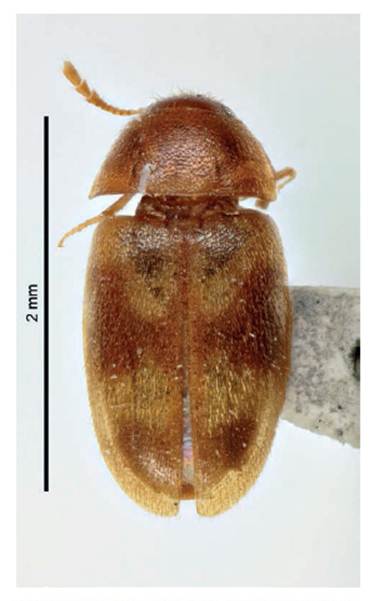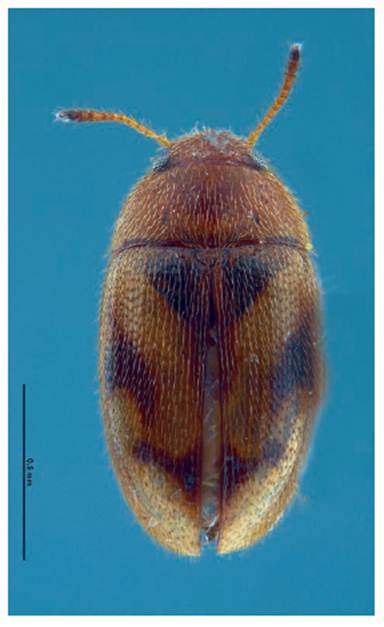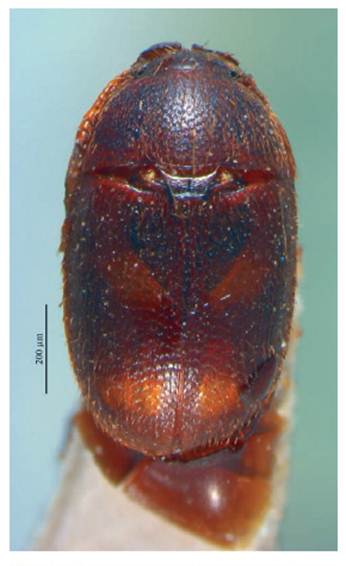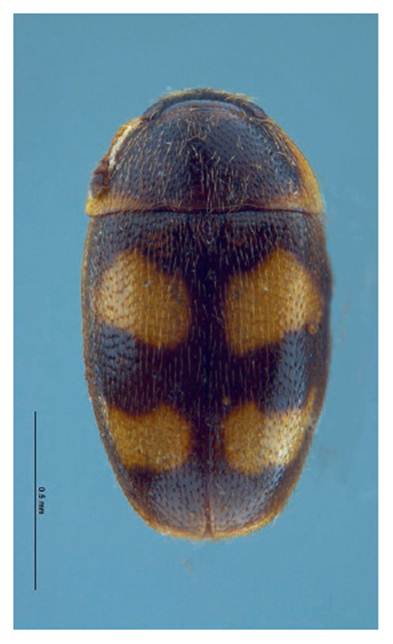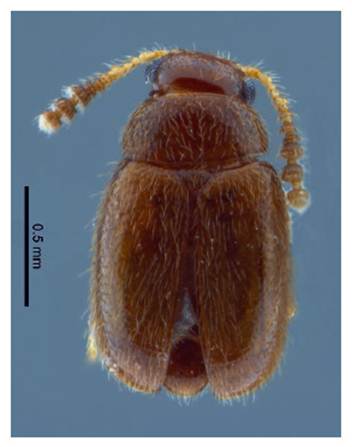Introduction
The “Beetles of Peru” is an ongoing project begun by Caroline Chaboo in 2007. It has involved a survey of literature, Peruvian field work and examination of specimens in multiple museums across the world. The goal has been to produce checklists for the 100 families of beetles currently known to occur in Peru. An overview of the project is provided in Chaboo (2015).
The family Mycetophagidae is divided into three subfamilies: Bergininae Leng, Esarcinae Reitter and Mycetophaginae Leach; previous to Lawrence et al. (2014) these were considered tribes. A key to the world genera is in Lawrence et al. (2014). Older descriptions are often short, general, not useful for identifying specimens, and devoid of specific locality information. The genera Filicivora Leschen & Lawrence, Litargus Erichson, Mycetophagus Hellwig, Nototriphyllus Lawrence, Escalona, Leschen & Ślipiński, Pseudochrodes Reitter, Pseudotriphyllus Reitter and Typhaea Stephens are recorded from South America (Lawrence et al. 2014), although only Litargus is recorded from Peru. Litargus currently has about 60 species found in the tropics and temperate regions of the world (Lawrence et al. 2014).
Recognition.- Mycetophagids are called the “hairy fungus beetles” (Young 2002). Family characteristics are provided by Young (2002) and Lawrence et al. (2014). Adults are small to medium sized (2 - 6 mm), covered with a dense setation and they have loosely compacted antennal clubs of 2 - 6 antennomeres. The tarsal formula is 3-4-4 or 4-4-4. Generally the body is brown to black, but it may have red, yellow or golden elytral maculation. Mycetophagidae has less than 200 species in 18 genera (Lawrence et al. 2014). Mycetophagids are sometimes confused with the family Biphyllidae but Biphyllidae has lateral and/or femoral lines on the first abdominal ventrite (Goodrich 2012). Mycetophagidae lacks those lines.
Habitats and collection.- The great majority of mycetophagids are associated with various types of soft fungi (both mycelia and fruiting bodies), especially from the Ascomycota or Basidiomycota. Typhaea stercorea (Linneaus) is cosmopolitan and found in stored grain facilities, as is Litargus balteatus LeConte. Less common taxa feed on pollen (Berginus Erichson) and fern spores (Filicivora Leschen & Lawrence). Larvae are usually found with the adults. Collection methods that often yield mycetophagids include: searching through the fruiting bodies of Basidiomycota, sifting leaf litter, sweeping, searching through stored grains, using Berlese funnels with various materials, peeling bark of dead trees, spraying pyrethrum on rotting logs and using light traps or sheets.
Material and methods
The following museums (and curators) provided information or specimens for this study.
CASC: California Academy of Sciences, San Francisco, CA, USA (Rachel Diaz-Bastin)
CDFA: California Department of Food & Agriculture, Sacramento, CA, USA (Martin Hauser)
FMNH: Field Museum of Natural History, Chicago, Illinois, USA (Crystal Maier)
FSCA: Florida State Collection of Arthropods, Gainesville, Florida, USA (Paul Skelly)
MFNB: Museum für Naturkunde, Berlin, Germany (Johannes Frisch and Bernd Jaeger)
SEMC: Snow Entomological Museum Collection, Lawrence, Kansas, USA (Zack Falin)
SMTD: Staaliches Museum für Tierkunde Dresden, Germany (Olaf Jaeger)
Label data.- The label data cited below are copied exactly from the specimen labels. One slash (/) represents different lines on one label and two slashes (//) represents different labels.
Results
Notes.- The following checklist of Peruvian Mycetophagidae was derived from Blackwelder (1945). Apparently no subsequent Peruvian records have appeared in print. Additional distribution information is derived from specimens from various museums. Without doubt more taxa will be found to occur in Peru after a systematic search for them.
Checklist of the Mycetophagidae of Peru
Mycetophaginae Leach, 1815
Litargus arcuatusErichson, 1847
Litargus quadrimaculatusKirsch, 1873
Thrimolus sp. Casey, 1900
Litargus arcuatus (Figs. 1-3)
PERU: Barranca / III-25-51 / Ross and Michelbacher (CASC, 1)
PERU: 16 km N of Barranca / III-15-51 / Ross and Michelbacher Collectors (CASC, 11)
PERU: Callao / XI-16-50 / Michelbacher and Ross (CASC, 3)
PERU: Callao / XI-16-50 / Michelbacher and Ross / sweeping in agric. area (CASC, 3)
PERU: Chaucay / III-25-51 / river valley / Ross and Michelbacher (CASC, 1)
PERU: Chaucay / river valley / III-15-51 / Ross and Michelbacher collectors (CASC, 2)
PERU, S. A. / Sept. 6 1937 / F. Woytkowski / No. 3784 // Dept. of Huanaco / vic. Of Huanaco / Andes 2000 m. a. s. l. / In streamlet (SEMC, 5)
PERU: Lima / 6 mi S San Antonio / 30 m, IX-13-1954 / E. I. Schlinger and E. S. Ross (CASC, 2)
PERU: Dept. Lima / Santa Elena (Fundo Pedregal) / 30-31-III-2011 / J. B. Heppner & C. Carrera (FSCA, 4)
PERU: Loreto Pr., 160 km / NE Iquitos, Explornapo / Camp, 2 km from Rio Napo / on Rio Sucusari, 7-31- / VIII-1992, P. Skelley / 15 w. black light trap (FSCA, 1)
PERU: Tambopala Prov. / 15 m NE Pto Maldonado / 19 July 1989, 200 m / J Ashe, R. Leschen, #592 / ex., at night on logs (SEMC, 1)
PERU: Molucella sp. / 12 Nov 2008 / MIAMI PPQ (Plant Pest Quarantine) (FSCA, 2)
Identification was made possible by translation of Erichson (1847). Photographs of the syntype (Fig. 1) and labels (Fig. 2), and a recent specimen (Fig. 3) are provided.
Litargus quadrimaculatus (Figs. 4-6)
PERU: 15 mi NE. Tingo Maria / IX-23-1954 / E. I. Schlinger & E.S. Ross (CASC, 1)
PERU: Amazonas Dept. / Chachapoyas, vic. / Gocta Lodge, 1815 m / 21-24-X-2012, J. E. Eger // S06°03’22.5” W077°53’42.6” (FSCA, 2)
PERU: Cuzco Dept. / Pillahuata, Manu Rd. / km 128, 22-IX-1982 // FMHD #82-276, on / flowers, L. E. / Watrous & G. Mazurek (FMNH, 1)
Peru, S. A. / Sept 6-1937 / F. Woytkowski / No. 3784 // Dept. of Huanuco / Vic. Of Huanuco / Andes 2000 m. a. s. l. / In streamlet (SEMC, 2)
Peru: Madre de Dios: / CICRA Field Stn., garden, malaise trap / PER 10-10-MAT-018 (SEMUC, 2)
Peru: Madre de Dios / CICRA Field Station / 12.56917°S 70.10019°W / 250-295 m / 10.VII.2010 Chaboo, / Bennet, Shin ex.UV light / PER 10-07-UV-4 (SEMC, 1)
PERU: Madre de Dios / CICRA Field Station, garden / 12.56940°S 70.10100°W / 260 m 26 VIII-2.IX.2010 / MJ Endara, malaise trap / PER 10-08-MAT-013 (SEMC, 1)
Peru: Madre de Dios / CICRA Field Station, garden / 12.56940°S 70.10100°W / 260 m, 2-9.IX.2010, MJ Endara, malaise trap / PER 10-09-MAT-014 (SEMC, 7)
Peru: Madre de Dios / CICRA Field Station, garden / 12.56940°S 70.10100°W / 260 m, 9-16.IX.2010, MJ Endara, malaise trap / PER 10-09-MAT-014 (SEMC, 1)
Peru: Madre de Dios / CICRA Field Station, garden / 12.56940°S 70.10100°W / 260 m, 16-23.IX.2010 / MJ Endara, malaise trap / PER 10-09-MAT-016 (SEMC, 8)
Peru: Madre de Dios / CICRA Field Station, garden / 12.56940°S 70.10100°W / 260 m, 23.IX-2.X.2010 / MJ Endara, malaise trap / PER 10-09-MAT-017 (SEMC, 4)
Peru: Madre de Dios / CICRA Field Station, garden / 12.56940°S 70.10100°W / 260 m, 2-11.X.2010 / MJ Endara, malaise trap / PER 10-09-MAT-018 (SEMC, 2)
Peru: Madre de Dios / CICRA Field Station, garden / 12.56940°S 70.10100°W / 260 m, 18-25.X.2010 / MJ Endara, malaise trap / PER 10-09-MAT-020 (SEMC, 4)
Peru: Madre de Dios / CICRA Field Station, garden / 12.56940°S 70.10100°W / 260 m, 25.X-1.XI.2010 / MJ Endara, malaise trap / PER 10-09-MAT-021 (SEMC, 1)
Peru: Madre de Dios / CICRA Field Station, garden / 12.56940°S 70.10100°W / 260 m, 1-8.XI.2010 / MJ Endara, malaise trap / PER 10-09-MAT-022 (SEMC, 1)
PERU: San Martin / Escalera Lodge / Tarapoto, 9-12-X-2012 / J. B. Heppner, 435 m (FSCA, 1)
PERU: San Martin Dept. / Moyabamba, vic. / Ecológico “Rumipata” / 13-18-X-2012, J. E. Egger // S06°04’32.0” W / 076°58’07.5”, 70 / m, UV light trap (FSCA, 2)
PERU, S. A. / Nov 25 1936 / F, Woytkowski / No. 3759 // Vicinity of Rioja / Dept. San Martin (SEMC, 1)
Peru S. A. / Sept 9-Oct 3 ’36 / F. Woytkowski / No. 3611 // Vic Rioja / Dept. San Martin / Jungle 900 m. a. s. l. (SEMC, 1)
Identification was made possible by translation of Kirsch (1873). Photographs of the type specimen (Fig. 4) and labels (Fig. 5), and a recent specimen (Fig. 6) are provided.
Other Litargus species - These Department records represent several other species, probably some described and some undescribed.
PERU: Amazonas (FSCA, 1; SEMC, 2), Cuzco (FMNH, 1), Huanuco (SEMC, 3), Junin (CDFA, 2; FSCA, 5, SEMC, 2), Loreto (FMNH, 6; FSCA, 20), Madre de Dios (FMNH, 1; SEMC, 7), Tambopata (SEMC, 47).
Thrimolus undescribed species (Fig. 7)
PERU: Tambopata Prov. / 15 km NE of Pto. Maldonado / 17 July, 200 m / J. Ashe, R. Leschen #537 / ex. Thelphoracue (SEMC, 1)
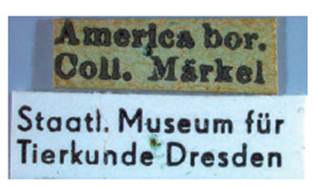
Figure 5 Labels on the type specimen of Litargus quadrimaculatus Kirsch. Photograph provided by SMTD.
Discussion
In summary, mycetophagids are known from all parts of Peru, north to south, from the Pacific coast to Amazonia and from near sea level to 200 m in the Andes. Peruvian mycetophagids have been collected using different traps and nets, and on plants and fungi. Mycetophagidae is fairly speciose in Peru and includes many undescribed species and at least one undescribed genus. The Peruvian mycetophagids are a very promising project awaiting further study. It is hoped that this paper will stimulate an interest in their examination and provide a start to finding specimens in museums around the world. But studying these taxa will require knowing the species that occur elsewhere in South America that might also occur in Peru.
In Litargus the shape, position and color of the elytral maculae are fairly good indicators of different species. Examination of specimens from the museums listed above has shown that there are many more species of Litargus present in Peru than the two that are described.
The Litargus quadrimaculatus type appears to lack the maculae described by Kirsch (Fig. 4). What appear to be the anterior maculae are actually the wings folded below the elytra. Perhaps the specimen is faded or maybe lipids bled from the body onto the elytra and obscured the maculae. Or perhaps this is not even the type given the label confusion (see below). Newer specimens show the maculae as Kirsch described them (Fig. 6).
The photograph of the L. quadrimaculatus type labels (Fig. 5) exposes an enigma in that it lists “America boreal” as the collection locality. This specimen is the only specimen for this species at SMTD although it does not bear any label as a type, something common to Kirsch types (Olaf Jaeger, in lit.). Boreal America (or America bor.) was a term used often in previous centuries to indicate unknown areas in the boreal forests of northern North America. The term “Coll. Märkel” indicates it is from the collection of Johann Christian Friedrich Märkel. Märkel was “a teacher near to Dresden” (Olaf Jaeger, in lit.) prior to Theodor Franz Wilhelm Kirsch being a curator at SMTD, and Kirsch knew of the Märkel collection. (Both collections are at SMTD.) But Kirsch (1873) lists the type of L. quadrimaculatus as coming from the collecting of Dr. Abendroth in Peru. Currently it is impossible to explain the discrepancy between the information on the specimen and the different information published by Kirsch. Since both the Kirsch and the Märkel collections are present in the same museum, there is a possibility that someone was studying Mycetophagidae and pulled specimens from both collections for examination and then simply put the wrong specimen back in Kirsch’s collection. Additional specimens of Litargus quadrimaculatus in the SEMC are from additional countries (Bolivia: El Bani and Santa Cruz Departments, and Paraguay: Itapua Department). Thus its distribution is not limited to Peru.
In boreal America there is the species L. tetraspilotus LeConte. While it has four spots on the elytra, it is easily separated from L. quadrimaculatus by the elytral setation being only in longitudinal lines, the elytral maculae being smaller and the body being less convex. Thus there is no possibility that Kirsch was somehow actually describing a specimen of L. tetraspilotus.












 uBio
uBio 

